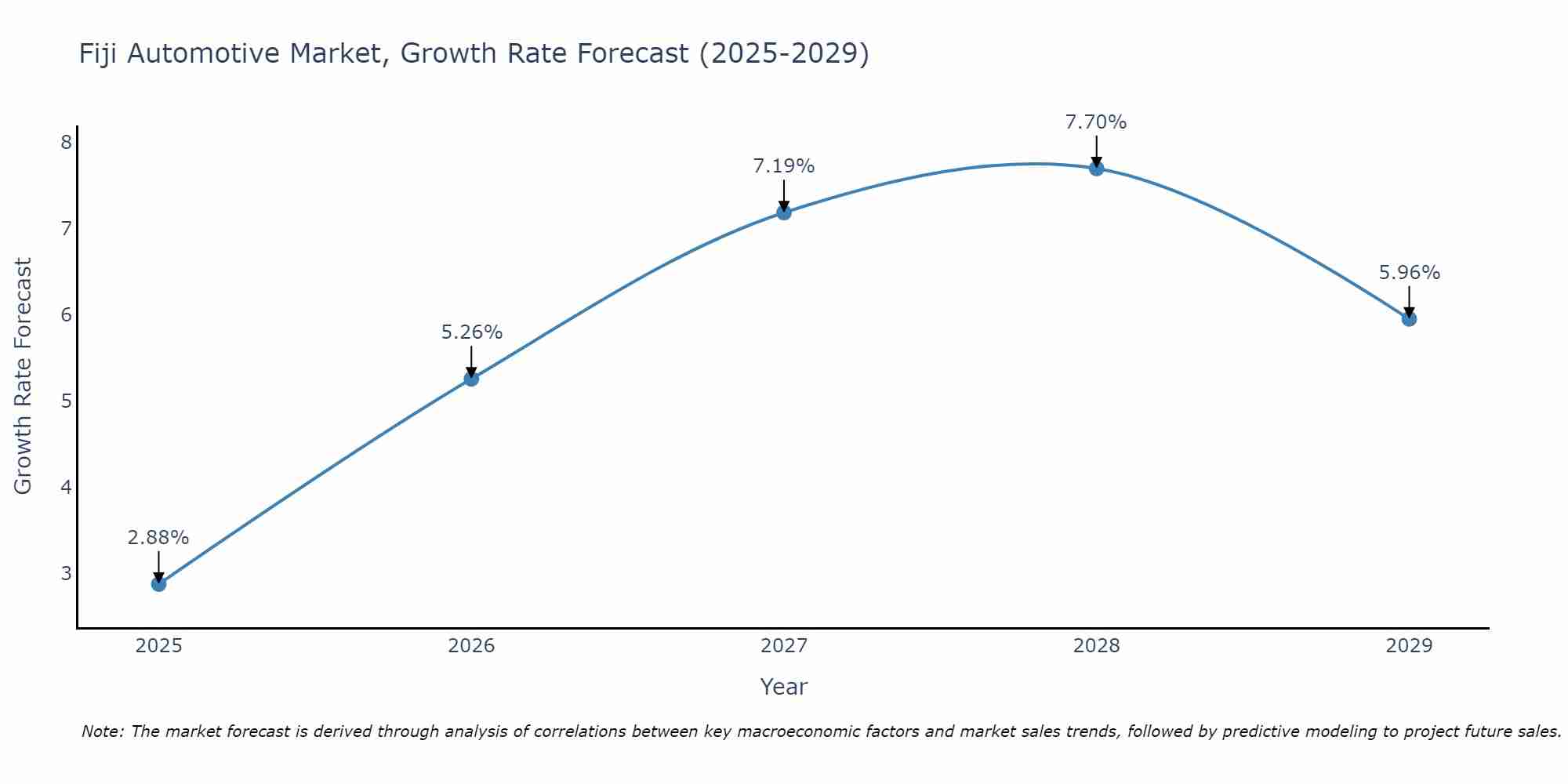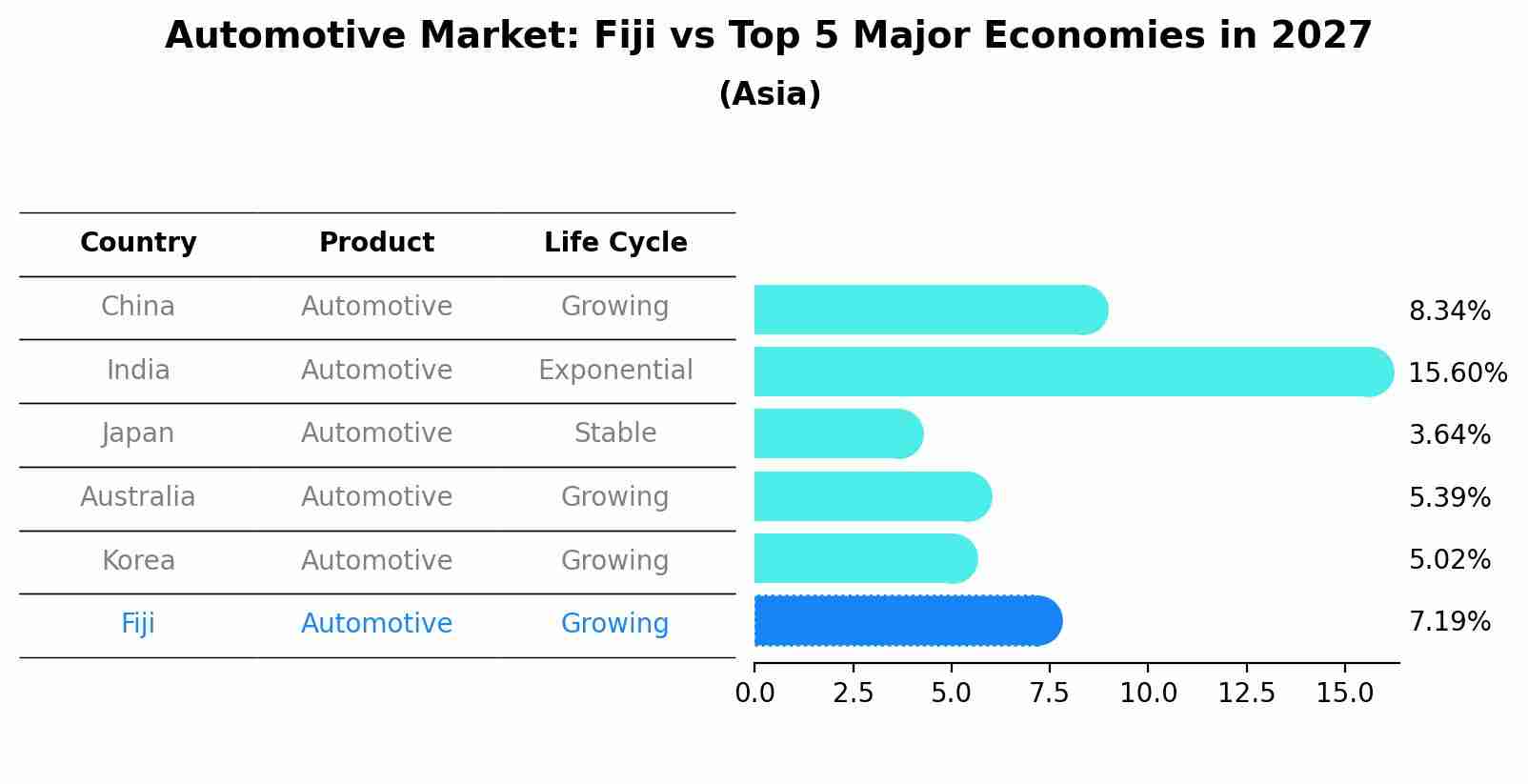Fiji Automotive Market (2025-2031) | Share, Analysis, Value, Companies, Size, Revenue, Trends, Forecast, Segmentation, Growth, Outlook & Industry
| Product Code: ETC5405021 | Publication Date: Nov 2023 | Updated Date: Oct 2025 | Product Type: Market Research Report | |
| Publisher: 6Wresearch | No. of Pages: 60 | No. of Figures: 30 | No. of Tables: 5 | |
Fiji Automotive Market Size Growth Rate
The Fiji Automotive Market is projected to witness mixed growth rate patterns during 2025 to 2029. Growth accelerates to 7.70% in 2028, following an initial rate of 2.88%, before easing to 5.96% at the end of the period.

Automotive Market: Fiji vs Top 5 Major Economies in 2027 (Asia)
The Automotive market in Fiji is projected to grow at a growing growth rate of 7.19% by 2027, within the Asia region led by China, along with other countries like India, Japan, Australia and South Korea, collectively shaping a dynamic and evolving market environment driven by innovation and increasing adoption of emerging technologies.

Key Highlights of the Report:
- Fiji Automotive Market Outlook
- Market Size of Fiji Automotive Market, 2024
- Forecast of Fiji Automotive Market, 2031
- Historical Data and Forecast of Fiji Automotive Revenues & Volume for the Period 2021-2031
- Fiji Automotive Market Trend Evolution
- Fiji Automotive Market Drivers and Challenges
- Fiji Automotive Price Trends
- Fiji Automotive Porter`s Five Forces
- Fiji Automotive Industry Life Cycle
- Historical Data and Forecast of Fiji Automotive Market Revenues & Volume By Product Type for the Period 2021-2031
- Historical Data and Forecast of Fiji Automotive Market Revenues & Volume By Electric for the Period 2021-2031
- Historical Data and Forecast of Fiji Automotive Market Revenues & Volume By Hybrid Electric for the Period 2021-2031
- Historical Data and Forecast of Fiji Automotive Market Revenues & Volume By Plug-In Hybrid Electric for the Period 2021-2031
- Historical Data and Forecast of Fiji Automotive Market Revenues & Volume By Mild Hybrid for the Period 2021-2031
- Historical Data and Forecast of Fiji Automotive Market Revenues & Volume By Natural Gas for the Period 2021-2031
- Historical Data and Forecast of Fiji Automotive Market Revenues & Volume By Fuel Cell Electric for the Period 2021-2031
- Historical Data and Forecast of Fiji Automotive Market Revenues & Volume By Diesel for the Period 2021-2031
- Historical Data and Forecast of Fiji Electric Automotive Market Revenues & Volume By Petrol for the Period 2021-2031
- Fiji Automotive Import Export Trade Statistics
- Market Opportunity Assessment By Product Type
- Fiji Automotive Top Companies Market Share
- Fiji Automotive Competitive Benchmarking By Technical and Operational Parameters
- Fiji Automotive Company Profiles
- Fiji Automotive Key Strategic Recommendations
Frequently Asked Questions About the Market Study (FAQs):
1 Executive Summary |
2 Introduction |
2.1 Key Highlights of the Report |
2.2 Report Description |
2.3 Market Scope & Segmentation |
2.4 Research Methodology |
2.5 Assumptions |
3 Fiji Automotive Market Overview |
3.1 Fiji Country Macro Economic Indicators |
3.2 Fiji Automotive Market Revenues & Volume, 2021 & 2031F |
3.3 Fiji Automotive Market - Industry Life Cycle |
3.4 Fiji Automotive Market - Porter's Five Forces |
3.5 Fiji Automotive Market Revenues & Volume Share, By Product Type, 2021 & 2031F |
4 Fiji Automotive Market Dynamics |
4.1 Impact Analysis |
4.2 Market Drivers |
4.2.1 Economic growth and rising disposable incomes in Fiji leading to increased consumer spending on vehicles. |
4.2.2 Infrastructure development and government investments in road networks improving accessibility and demand for automobiles. |
4.2.3 Growing tourism industry in Fiji creating a need for transportation services and rental vehicles. |
4.3 Market Restraints |
4.3.1 High import duties and taxes on vehicles making them expensive for consumers in Fiji. |
4.3.2 Limited availability of financing options for purchasing vehicles affecting affordability. |
4.3.3 Lack of skilled automotive technicians and service centers impacting maintenance and after-sales service quality. |
5 Fiji Automotive Market Trends |
6 Fiji Automotive Market Segmentations |
6.1 Fiji Automotive Market, By Product Type |
6.1.1 Overview and Analysis |
6.1.2 Fiji Automotive Market Revenues & Volume, By Electric, 2021-2031F |
6.1.3 Fiji Automotive Market Revenues & Volume, By Hybrid Electric, 2021-2031F |
6.1.4 Fiji Automotive Market Revenues & Volume, By Plug-In Hybrid Electric, 2021-2031F |
6.1.5 Fiji Automotive Market Revenues & Volume, By Mild Hybrid, 2021-2031F |
6.1.6 Fiji Automotive Market Revenues & Volume, By Natural Gas, 2021-2031F |
6.1.7 Fiji Automotive Market Revenues & Volume, By Fuel Cell Electric, 2021-2031F |
6.1.9 Fiji Automotive Market Revenues & Volume, By Petrol, 2021-2031F |
6.1.10 Fiji Automotive Market Revenues & Volume, By Petrol, 2021-2031F |
7 Fiji Automotive Market Import-Export Trade Statistics |
7.1 Fiji Automotive Market Export to Major Countries |
7.2 Fiji Automotive Market Imports from Major Countries |
8 Fiji Automotive Market Key Performance Indicators |
8.1 Average vehicle age in Fiji, indicating the rate of vehicle turnover and potential for new vehicle sales. |
8.2 Number of new vehicle registrations, reflecting the demand for automobiles in the market. |
8.3 Average distance traveled per vehicle, showing the utilization rate and potential for replacement or additional vehicle purchases. |
8.4 Average maintenance cost per vehicle, indicating the overall health of the automotive market and consumer spending on vehicle upkeep. |
8.5 Adoption rate of electric or hybrid vehicles, showcasing the market's responsiveness to sustainable and innovative automotive technologies. |
9 Fiji Automotive Market - Opportunity Assessment |
9.1 Fiji Automotive Market Opportunity Assessment, By Product Type, 2021 & 2031F |
10 Fiji Automotive Market - Competitive Landscape |
10.1 Fiji Automotive Market Revenue Share, By Companies, 2024 |
10.2 Fiji Automotive Market Competitive Benchmarking, By Operating and Technical Parameters |
11 Company Profiles |
12 Recommendations | 13 Disclaimer |
- Single User License$ 1,995
- Department License$ 2,400
- Site License$ 3,120
- Global License$ 3,795
Search
Related Reports
- ASEAN Bearings Market (2025-2031) | Strategy, Consumer Insights, Analysis, Investment Trends, Opportunities, Growth, Size, Share, Industry, Revenue, Segments, Value, Segmentation, Supply, Forecast, Restraints, Outlook, Competition, Drivers, Trends, Demand, Pricing Analysis, Competitive, Strategic Insights, Companies, Challenges
- Europe Flooring Market (2025-2031) | Outlook, Share, Industry, Trends, Forecast, Companies, Revenue, Size, Analysis, Growth & Value
- Saudi Arabia Manlift Market (2025-2031) | Outlook, Size, Growth, Trends, Companies, Industry, Revenue, Value, Share, Forecast & Analysis
- Uganda Excavator, Crane, and Wheel Loaders Market (2025-2031) | Strategy, Consumer Insights, Analysis, Investment Trends, Opportunities, Growth, Size, Share, Industry, Revenue, Segments, Value, Segmentation, Supply, Forecast, Restraints, Outlook, Competition, Drivers, Trends, Demand, Pricing Analysis, Competitive, Strategic Insights, Companies, Challenges
- Rwanda Excavator, Crane, and Wheel Loaders Market (2025-2031) | Strategy, Consumer Insights, Analysis, Investment Trends, Opportunities, Growth, Size, Share, Industry, Revenue, Segments, Value, Segmentation, Supply, Forecast, Restraints, Outlook, Competition, Drivers, Trends, Demand, Pricing Analysis, Competitive, Strategic Insights, Companies, Challenges
- Kenya Excavator, Crane, and Wheel Loaders Market (2025-2031) | Strategy, Consumer Insights, Analysis, Investment Trends, Opportunities, Growth, Size, Share, Industry, Revenue, Segments, Value, Segmentation, Supply, Forecast, Restraints, Outlook, Competition, Drivers, Trends, Demand, Pricing Analysis, Competitive, Strategic Insights, Companies, Challenges
- Angola Excavator, Crane, and Wheel Loaders Market (2025-2031) | Strategy, Consumer Insights, Analysis, Investment Trends, Opportunities, Growth, Size, Share, Industry, Revenue, Segments, Value, Segmentation, Supply, Forecast, Restraints, Outlook, Competition, Drivers, Trends, Demand, Pricing Analysis, Competitive, Strategic Insights, Companies, Challenges
- Israel Intelligent Transport System Market (2025-2031) | Strategy, Consumer Insights, Analysis, Investment Trends, Opportunities, Growth, Size, Share, Industry, Revenue, Segments, Value, Segmentation, Supply, Forecast, Restraints, Outlook, Competition, Drivers, Trends, Demand, Pricing Analysis, Competitive, Strategic Insights, Companies, Challenges
- Uganda Precast and Aggregate Market (2025-2031) | Strategy, Consumer Insights, Analysis, Investment Trends, Opportunities, Growth, Size, Share, Industry, Revenue, Segments, Value, Segmentation, Supply, Forecast, Restraints, Outlook, Competition, Drivers, Trends, Demand, Pricing Analysis, Competitive, Strategic Insights, Companies, Challenges
- Australia IT Asset Disposal Market (2025-2031) | Strategy, Consumer Insights, Analysis, Investment Trends, Opportunities, Growth, Size, Share, Industry, Revenue, Segments, Value, Segmentation, Supply, Forecast, Restraints, Outlook, Competition, Drivers, Trends, Demand, Pricing Analysis, Competitive, Strategic Insights, Companies, Challenges
Industry Events and Analyst Meet
Our Clients
Whitepaper
- Middle East & Africa Commercial Security Market Click here to view more.
- Middle East & Africa Fire Safety Systems & Equipment Market Click here to view more.
- GCC Drone Market Click here to view more.
- Middle East Lighting Fixture Market Click here to view more.
- GCC Physical & Perimeter Security Market Click here to view more.
6WResearch In News
- Doha a strategic location for EV manufacturing hub: IPA Qatar
- Demand for luxury TVs surging in the GCC, says Samsung
- Empowering Growth: The Thriving Journey of Bangladesh’s Cable Industry
- Demand for luxury TVs surging in the GCC, says Samsung
- Video call with a traditional healer? Once unthinkable, it’s now common in South Africa
- Intelligent Buildings To Smooth GCC’s Path To Net Zero













